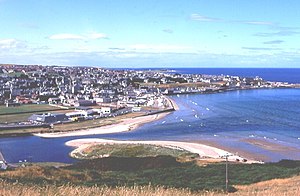Template:FP-Banff: Difference between revisions
Jump to navigation
Jump to search
mNo edit summary |
No edit summary |
||
| Line 6: | Line 6: | ||
The origin of the name "Banff" is uncertain but may be derived from the Gaelic ''Banbh'' or ''Banbha'', a sow, or a contraction of ''Bean-naomh'', 'the holy woman' (as is reflected in the town's coat-of-arms). | The origin of the name "Banff" is uncertain but may be derived from the Gaelic ''Banbh'' or ''Banbha'', a sow, or a contraction of ''Bean-naomh'', 'the holy woman' (as is reflected in the town's coat-of-arms). | ||
Banff's first castle was built to repel Viking invaders. King Malcolm IV issued a charter in 1163 while lodged in Banff. During this period the town was a busy trading centre in the "free hanse" of northern burghs, despite not having its own harbour until 1775. Royal Burgh status was conferred by King Robert II in 1372.}}<noinclude> | Banff's first castle was built to repel Viking invaders. King Malcolm IV issued a charter in 1163 while lodged in Banff. During this period the town was a busy trading centre in the "free hanse" of northern burghs, despite not having its own harbour until 1775. Royal Burgh status was conferred by King Robert II in 1372.}}<noinclude>{{FP data}} | ||
Latest revision as of 18:49, 5 May 2021
 |
BanffBanff is the county town of Banffshire. It stands on Banff Bay and faces the town of Macduff across the estuary of the River Deveron. The origin of the name "Banff" is uncertain but may be derived from the Gaelic Banbh or Banbha, a sow, or a contraction of Bean-naomh, 'the holy woman' (as is reflected in the town's coat-of-arms). Banff's first castle was built to repel Viking invaders. King Malcolm IV issued a charter in 1163 while lodged in Banff. During this period the town was a busy trading centre in the "free hanse" of northern burghs, despite not having its own harbour until 1775. Royal Burgh status was conferred by King Robert II in 1372. (Read more) |